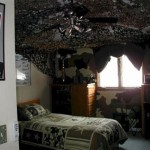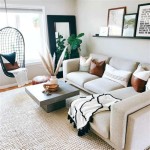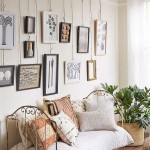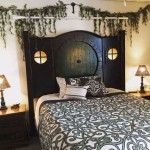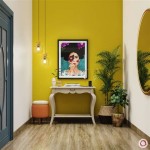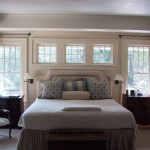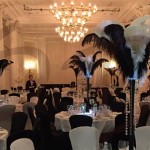Creating a 70s Rock Room: A Guide to Authentic Decor
The 1970s represent a dynamic decade for rock music, marked by experimentation, evolution, and a vibrant cultural landscape. Capturing the essence of this era within a dedicated space requires careful consideration of color palettes, furniture styles, iconic imagery, and the overall atmosphere that defined the period. This article provides guidance on recreating an authentic 70s rock room, serving as a resource for enthusiasts seeking to immerse themselves in the decade’s unique aesthetic.
Color Palettes and Textures
Color played a significant role in defining the 70s aesthetic, moving beyond the bright psychedelia of the previous decade towards earthier, more grounded tones. Avocado green, mustard yellow, burnt orange, and various shades of brown and beige were prominent. These colors were often used in combination to create a warm and inviting, albeit sometimes visually overwhelming, environment.
Walls could be painted a solid color, or adorned with patterned wallpaper. Geometric designs, floral motifs (often stylized and large-scale), and even faux wood paneling were popular choices. The key was to create a visual texture that added depth and interest to the room.
Beyond paint and wallpaper, textiles played a crucial part in the 70s color story. Shag carpets, often in deep browns, oranges, or greens, were a defining feature. Throw pillows in a variety of textures, such as velvet, corduroy, or macrame, further enhanced the sensory experience. Consider incorporating these elements to accurately represent the intended era.
Lighting could also subtly contribute to the overall color scheme. Lamps with colored glass shades, such as amber or orange, could cast a warm glow, further reinforcing the earthy tones. Dimmer switches were also frequently used to adjust the level of illumination, contributing to a more relaxed and intimate atmosphere.
Furniture and Furnishings
Furniture in the 1970s often leaned towards comfort and informality. Modular seating, such as beanbag chairs and sectional sofas, were common choices. These pieces encouraged relaxation and a more casual approach to living spaces. Low-slung furniture, placed close to the ground, was also typical of the era.
Materials like wood, particularly dark wood finishes, were prevalent. Coffee tables with hairpin legs, side tables made of wood or glass, and shelving units with a minimalist design were frequently incorporated. Rattan and wicker furniture also saw a surge in popularity, adding a natural element to the room.
Consider incorporating vintage finds to enhance authenticity. Thrift stores and antique shops can be valuable resources for sourcing original 70s furniture. Look for pieces with clean lines, geometric shapes, and materials characteristic of the decade. Vinyl records, housed in wooden crates or dedicated shelves, also served as functional decor, prominently displaying one's musical tastes.
Lighting fixtures prevalent in the 70s included lava lamps, which provided both visual interest and a soft, ambient light. Tiffany-style lamps, with their stained-glass shades, also added a touch of elegance. String lights, draped around the room or used to highlight specific features, could create a festive and inviting atmosphere. Proper lighting is crucial for capturing the ambiance of a 70s rock room.
Iconic Imagery and Memorabilia
The 70s rock scene produced a wealth of iconic imagery that can be incorporated into a themed room. Album covers, posters, and photographs of prominent musicians served as visual anchors, instantly establishing the room’s focus. Framed album covers, particularly those of classic rock bands like Led Zeppelin, Pink Floyd, and The Rolling Stones, are a particularly effective choice.
Posters, often featuring psychedelic designs or images of famous concerts, were a staple of 70s decor. These could be sourced from vintage poster shops or reproduced from original designs. Large-format posters, displayed prominently on walls, made a bold statement. Black light posters, which glowed under ultraviolet light, were also popular, adding a psychedelic touch.
Consider incorporating memorabilia related to specific bands or musical genres. Concert tickets, backstage passes, and signed autographs can add a personal touch to the room. Displaying these items in shadow boxes or framed displays can protect them and create an interesting focal point. Instruments, such as a vintage electric guitar or a set of drums, can also serve as striking decorative elements, although space considerations are paramount.
Beyond musician-specific imagery, consider incorporating visual elements that represent the broader cultural landscape of the 70s. Vintage advertisements, movie posters, and magazine covers can provide a glimpse into the era's aesthetic and cultural values. These items can be found online or at antique shops, and can be displayed in a variety of ways, from framed prints to collages.
Audio Equipment and Sound System
No 70s rock room is complete without a suitable audio system. During this era, quality audio equipment was paramount for enjoying music to its fullest. A vintage stereo system, consisting of a turntable, amplifier, and speakers, is an essential element for recreating an authentic experience. Turntables from brands like Technics, Pioneer, and Dual were highly regarded for their performance and reliability.
Amplifiers from brands like Marantz, Sansui, and McIntosh were known for their warm sound and robust construction. Speakers with large woofers and detailed tweeters were designed to reproduce the full range of frequencies found in rock music. Consider sourcing vintage audio equipment from reputable dealers or online marketplaces, ensuring that it is in good working condition.
Beyond the core components of a stereo system, consider incorporating other audio-related items. Cassette tapes, 8-track tapes, and vinyl records can be displayed to showcase the era's dominant music formats. Empty tape cases, stored in a vintage carrying case, can add a touch of authenticity. Period-correct headphones, such as those produced by Koss or Sennheiser, can also be displayed as decorative elements.
The acoustic properties of the room should also be considered. Soft furnishings, such as shag carpets and upholstered furniture, can help to absorb sound and reduce reverberation. Acoustic panels, covered in fabric or vintage-inspired designs, can also be used to improve the sound quality of the room. Careful attention to acoustics can enhance the overall listening experience and create a more immersive environment.
Lighting and Ambiance
Lighting played a crucial role in setting the mood in the 70s. Soft, diffused light was preferred over harsh, direct illumination. This created a more relaxed and intimate atmosphere, conducive to listening to music and socializing.
Lava lamps, mentioned previously, were a quintessential lighting element of the 70s. Their mesmerizing, slow-moving wax provided a visual focal point and a soft, ambient light. Tiffany lamps, with their stained-glass shades, added a touch of elegance and sophistication. String lights, draped around the room or used to highlight specific features, could create a festive and inviting atmosphere.
Dimmer switches were commonly used to adjust the level of illumination, allowing for greater control over the room's ambiance. Low-wattage light bulbs, often with a warm color temperature, created a soft and inviting glow. Candles, strategically placed around the room, could also add to the romantic and atmospheric feel.
Beyond artificial lighting, natural light should also be considered. Sheer curtains or blinds allowed natural light to filter into the room without being too harsh. Plants, strategically placed near windows, could also help to soften the light and add a touch of nature to the space. The interplay between natural and artificial light can contribute significantly to the overall ambiance of a 70s rock room.
Personal Touches and Customization
While recreating an authentic 70s rock room involves incorporating specific design elements and furnishings, it is also important to add personal touches to make the space unique and reflective of individual tastes. Customization can elevate the room beyond a mere imitation and create a truly personalized environment.
Consider incorporating items that hold personal significance, such as concert souvenirs, photographs of favorite bands, or handmade crafts. These items can add a personal narrative to the room and make it feel more lived-in and authentic. Displaying these items in a creative and visually appealing way can further enhance their impact.
Don't be afraid to experiment with different textures, patterns, and colors to create a space that is both visually appealing and comfortable. The 70s were a time of experimentation and self-expression, so embrace that spirit when designing your rock room. Mix and match different styles, combine vintage finds with contemporary pieces, and create a space that is truly your own.
Ultimately, the goal of creating a 70s rock room is to evoke the spirit of the era and create a space that is both nostalgic and functional. By carefully considering the various design elements and incorporating personal touches, it is possible to create a room that is a fitting tribute to one of the most influential decades in rock music history.

My Houzz Groovy 1970s Retro Pad In Los Angeles Bedrooms Room 70s Home Decor

Pin On Interiors

Room Upgrade Rock Punk Retro

20 Awesome Hippie Bedrooms Ideas Bedroom Bedroomdecor Bedroomdecorideas Grunge Room Inspiration Hippy

20 Coolest Rock N Roll Decor For Your Home Homemydesign Rooms Living Room Designs

20 Punk Rock Bedroom Ideas Homemydesign Grunge

Rock Out Mid Century Modern House 70s Retro Home Decor

Garish Rooms Of The 70s Go Retro

10 Ways To Decorate Your House Like The 1970s Without Making It Feel Dated

Vintage Rock Band Posters Set Of 9 70s 80s 90s Retro Room Wall Decor
